It’s the homeland of a top-rated tennis player, its capital city has some of the best nightlife in the world, and the land has been inhabited for at least 8,000 years. Where is Serbia?
Serbia is located in Southeastern and Central Europe.
Precise Location Coordinates of Serbia
The DMS (Degrees, Minutes, Seconds) coordinates for the center of Serbia are:
- 44° 0′ 59.48” N
- 21° 0′ 21.09” E
The latitude and longitude of Serbia are:
- Latitude: 44.016521
- Longitude: 21.005859
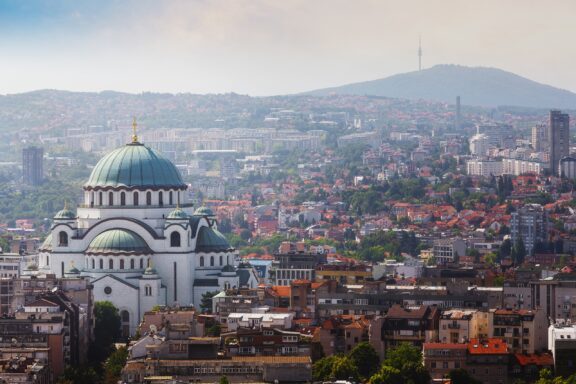
You can see the location of Serbia on the world map below:

Serbia Neighboring Countries
As a landlocked country in Southeastern Europe, Serbia has quite a few neighbors. It shares foreign borders with eight different countries, though one of the borders is disputed.
Serbia claims the area of Kosovo as its own and therefore claims it borders Albania. Kosovo has claimed independence since 2008.
The neighboring countries of Serbia (RS) are:
- Albania (AL) – if Kosovo is considered part of Serbia.
- Bosnia and Herzegovina (BA)
- Bulgaria (BG)
- Croatia (HR)
- Hungary (HU)
- Montenegro (ME)
- North Macedonia (MK)
- Romania (RO)
- Kosovo (XK)
Serbia Interesting Facts
- The Đerdap Gorge in Serbia is one of the largest in all of Europe.
- Pule, the world’s most expensive cheese, comes from Serbia.
- Serbia is among the largest raspberry producers in the world.
Maritime Borders
As a landlocked country, Serbia doesn’t have direct access to any seas or oceans. The largest body of water in Serbia is Vlasina Lake, an artificial lake with a total area of 16 km2 (6.2 sq mi).
Administrative Divisions of Serbia
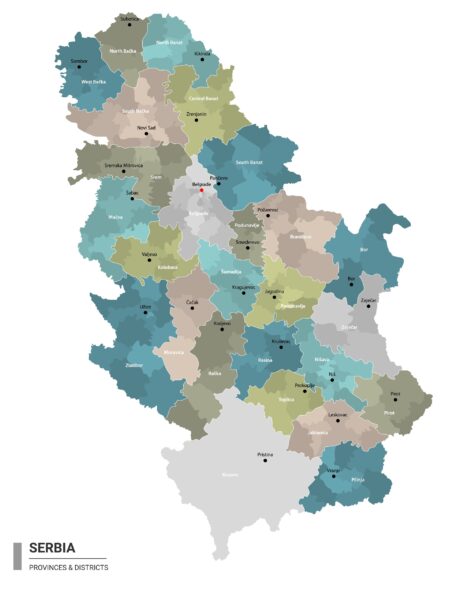
Serbia can be divided into 24 or 29 districts, and these are the highest administrative divisions in the country. Belgrade, the capital of Serbia, has its own similar status. Five of the 29 districts lie within Kosovo, which has declared its independence from Serbia, though Serbia does not recognize Kosovo’s independence.
The districts of Serbia get their names from geographic and historic regions or geographic features like rivers. Each district is headed by a commissioner, though they are not considered units of self-governance.
The most populous district in Serbia is South Bačka District, and the largest in size is Zlatibor District, with an area of 6,140 km2.
After districts, Serbia is divided into municipalities and cities, which are the smallest units of self-governance. There are 145 municipalities and 29 cities in Serbia, excluding Kosovo.
Geography of Serbia
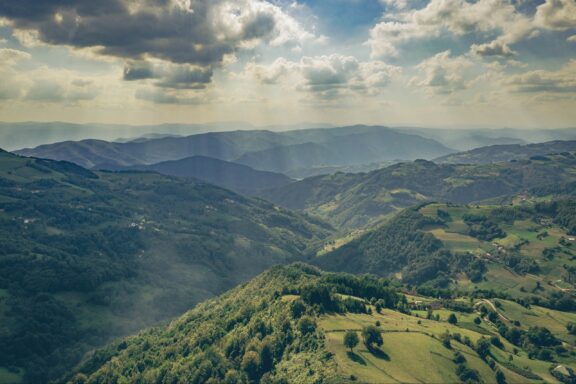
Excluding Kosovo, Serbia covers an area of 77,474 km² (29,912.9 mi2) at the crossroads of Central and Southeastern Europe. The Danube is often considered to be the northern border of the Balkan countries, which places roughly 75% of Serbia in this territory.
Although Serbia is landlocked and does not directly border any major bodies of water, it has access to the Black Sea through the Danube, and the Adriatic is the closest sea. Belgrade is one of several European capitals that lie along the Danube.
Serbia’s topography varies throughout the country and includes fertile plains, several mountain ranges, major rivers, lakes, and gorges. The Vojvodina region in northern Serbia is dominated by the Danube and Tisa rivers and is home to the country’s fertile plains.
The large central part of Serbia consists mostly of low-lying hills and modest mountain ranges, and the tallest mountains in the country are located in the southeast in the Balkan Mountains. The highest peak in Serbia belongs to Midžor, which stands at 2,169 meters (7,116 ft) above sea level.
History of Serbia
The history of Serbia is complex and spans a vast period of time. It starts with humans inhabiting the area in the Early Stone Age and the many states and peoples that preceded present-day Serbia.
The territory owes part of its complex history to its strategic location along the Danube and between Western Europe and Asia. Belgrade, in particular, has been the focus of many brutal campaigns. It’s been involved in 115 wars and has been destroyed and rebuilt an amazing 44 times.
One of the most prominent early medieval states of Serbia was the principality of Vlastimirovići, founded in the seventh century AD and named after Prince Vlastimir. The principality grew into the Kingdom of Serbia in 1217 and later transformed into the Serbian Empire in 1345. The empire included most of the Balkans.
The reign of the Serbian Empire was short-lived due to the invasion of Ottoman forces from the East. Starting in the late 14th century, there were three centuries of Ottoman occupation and rule in the Balkans, during which there were many uprisings by Serbs attempting to regain independence.
The Serbian Revolution that began towards the beginning of the 19th century marked the start of what would lead to Serbia’s full independence. By the end of World War I, after the defeat of the Austro-Hungarian Empire, the Kingdom of Serbs, Croats, and Slovenes was established in 1918. The Kingdom is better known as Yugoslavia, of which Belgrade was the capital.
Serbia gained its current borders as a federal unit within Yugoslavia at the end of World War II in 1945. Yugoslavia dissolved in the early 1990s, and Serbia became an independent nation after forming a union with Montenegro for several years.
In 2008, self-declared representatives of Albanians of Kosovo (the largest ethnic group in Kosovo) declared independence from Serbia. Just over half of UN member countries recognize Kosovo’s independence.
Serbia is not currently a member of the Schengen Area or the European Union, but it applied for accession to the EU in 2009.
Culture and People of Serbia
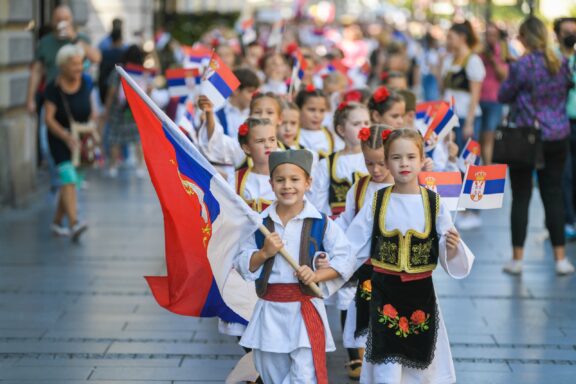
As per Serbia’s 2022 census, the country’s population is 6,690,887. Serbia is among the top countries with declining populations in Europe, a trend that began in the 1990s. A high level of emigration and low birth rates paired with high death rates are the primary causes of the decline.
Belgrade is the most populous city in the country by a large margin. It is the only city with more than one million residents.
In this section, we’ll learn about the ethnicities, religions, and traditions represented by the Serbian people.
Ethnicity
Ethnic Serbs are by far the largest ethnic group in Serbia, representing more than 80% of the population. This figure excludes the population of Kosovo. The two largest ethnic minorities in Serbia are Hungarian and Romani.
There are many other European minorities in Serbia, including Croats, Slovaks, Albanians, Montenegrins, Romanians, and Bulgarians, among others.
The largest non-European ethnic minority in Serbia is Chinese, owing to a recent history of Chinese migrants entering the West via Serbia.
Religion
The constitution of Serbia defines the country as a secular state and guarantees religious freedom for its citizens.
The traditional and largest church in the country is the Serbian Orthodox Church, and together with various other Orthodox Christian communities in the country, more than 80% of the population is Orthodox Christian. The Church of Saint Sava in Belgrade is one of the largest Orthodox churches in the world.
Other religious groups in Serbia are Catholics, Muslims, and Protestants. The Jewish population in Serbia consists of less than 100 people, and about 1% of the population identifies as atheists.
Language
The official language and mother tongue of 88% of Serbians in 2011 is Serbian. Notably, it is the only European language to actively use two scripts: Cyrillic and the Latin alphabet. Serbian Cyrillic is designated as the official script in the nation’s constitution, but almost half of Serbians prefer the Latin alphabet according to a 2014 survey.
Serbian is very similar and mutually intelligible with Bosnian and Croatian. Other recognized minority languages in Serbia are Albanian, Hungarian, Slovak, Romanian, Bulgarian, Rusyn, and Macedonian.
Cuisine
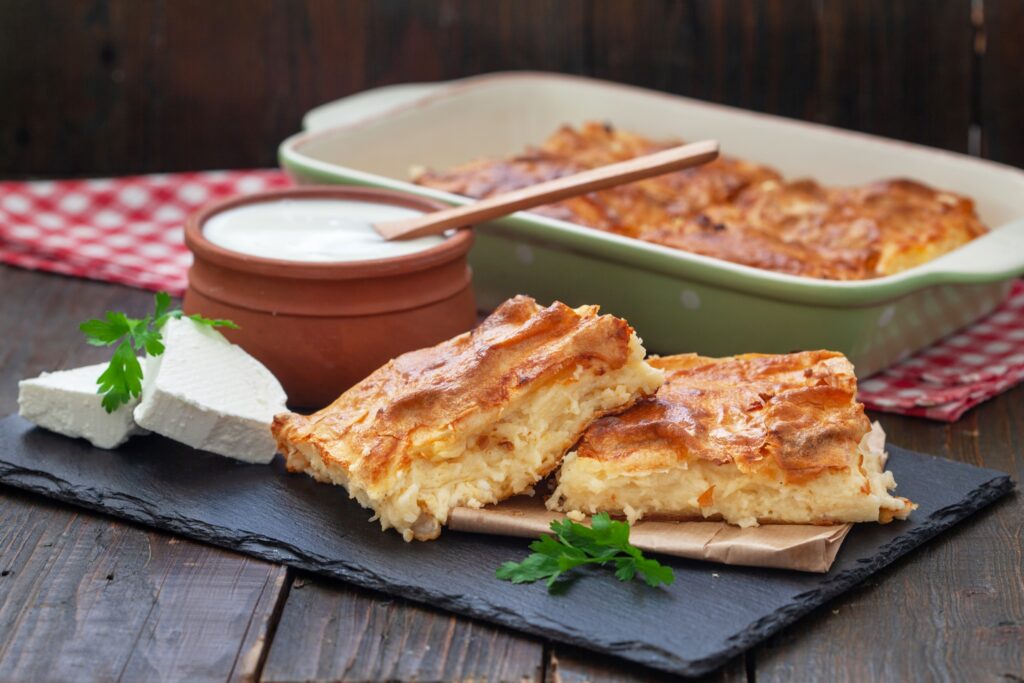
Serbian food is typically richer in animal products than in fresh vegetables because of the country’s pastoral customs involving the keeping of livestock. There are also many basic grains in Serbian cuisine, such as corn, wheat, and oats.
Cooking styles from Europe and the Middle East have both influenced the cuisine of Serbia, and it shares many characteristics with the foods of other Balkan countries.
Traditional dishes include sarma — meat rolled in cabbage leaves — and gibanica — an egg and cheese pie.
Arts
Serbian art reaches back to the medieval period, where Byzantine art can still be seen in the architecture of the country’s castles and monasteries as well as painted frescos.
The Museum of Contemporary Art and the Zepter Museum, both located in Belgrade, showcase some of the country’s best pieces, and the National Museum of Serbia has one of the largest art collections in the Balkans.
Traditional Serbian folk music makes use of a multitude of instruments, including bagpipes, flutes, horns, and lutes, among others. The traditional folk dance is called kolo, and sung epic poetry is an integral part of traditional Serbian music.
Other music genres in the country include Serbian pop and rock. Serbian artist Marija Šerifović won the 2007 Eurovision Song Contest.
Biggest Cities in Serbia
Here are the largest cities in Serbia based on 2021 data:
| City | Population |
|---|
| Belgrade | 1,378,682 | Novi Sad | 380,000 | Nis | 183,164 | Zemun | 161,596 | Kragujevac | 150,623 | Valjevo | 90,312 | Loznica | 86,413 | Zrenjanin | 76,511 | Pancevo | 76,203 | Cacak | 71,883 |
Major Cities
The largest city by a long shot in Serbia is its capital, Belgrade. The next largest city in the country has a population that’s only 20% of what the capital has. We’ll take a look at the four largest cities in Serbia, starting with the capital.
Belgrade
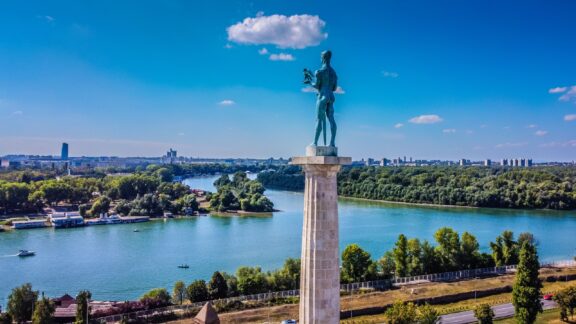
The estimated population of Belgrade in 2022 in 1,405,192 people. This makes it the largest city in Serbia by a massive margin. Belgrade is a historic city located on a plateau at the confluence of the Danube and Sava Rivers, both important rivers in the region.
Historically, Belgrade is a heavyweight. It’s one of the oldest continuously inhabited cities in Europe and the world. The city has been inhabited by a number of different civilizations throughout its long history, some of which include the Vinča culture, Thraco-Dacians, Celts, Romans, and Slavs. Control of the city has passed between the Byzantine, Frankish, Bulgarian, Ottoman, and Habsburg Empires. Belgrade was also the capital of Yugoslavia from 1918 until 1941.
Perhaps the primary reason Belgrade has been important to so many civilizations is that it occupies a strategic position. This has caused it to be involved in at least 115 wars and razed 44 times. It’s also been bombed five times and besieged many more.
Today, the city is the third largest on the Danube River and the primate city of Serbia. It is the economic and administrative center of the country, meaning all the largest Serbian corporations are based in the city, and the country’s governmental organizations are also headquartered here.
Things to see and do in Belgrade
1. Belgrade Fortress
This is definitely the most iconic landmark in the city, as it overlooks the Danube and Sava Rivers and is free to explore. A fortress existed in this site as early as 279 BCE, though it was repeatedly destroyed and rebuilt over the centuries.
The fortress is now a popular place to watch the sunset and to have a picnic, as it is surrounded by a large park with trees. Other attractions at the fortress are a water well from the Roman era, a military museum, and a clock tower.
2. Skadarlija
Skadarlija is a street and neighborhood in Belgrade’s Old Town, known as Stari Grad in Serbian. After the Belgrade Fortress, it is the second most popular destination among visitors to the city, and it’s frequented by locals as well.
The street is populated with traditional local restaurants, well known hotels, and shops selling souvenirs and antiques. It is the center of Belgrade’s Bohemian Quarter.
3. Temple of Saint Sava
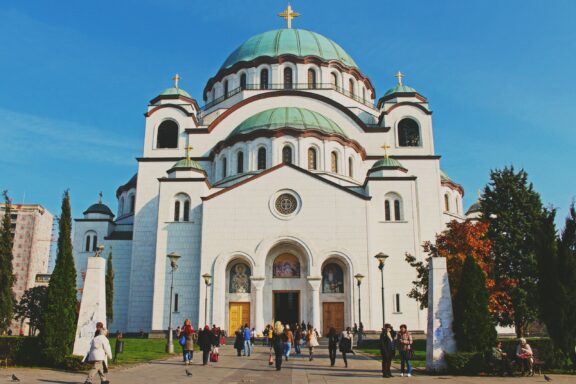
This Serbian Orthodox church ranks among the largest churches in the world. It was modeled on the design and dimensions of the Hagia Sofia and was completed in 1989, though construction began in 1935. It is located on the presumed location of the grave of Saint Sava, the founder of the Serbian Orthodox Church.
Entry into the church is free, and there are souvenir shops located within.
Novi Sad
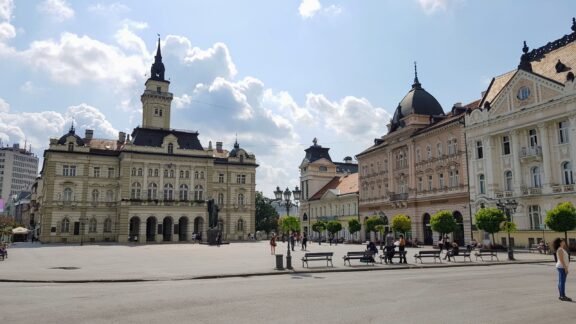
This is the second largest city in Serbia, and it’s the capital of the Vojvodina Province. The city lies in the northern region of the country on the northern banks of the Danube River. Novi Sad was founded in 1694 and was historically referred to as the “Serbian Athens” for its importance as a trading, manufacturing, and cultural center.
In recent times, Novi Sad was chosen as the European Youth Capital in 2019 and the European Capital of Culture in 2022. It’s known for hosting the annual EXIT summer music festival, which has been rated as one of the best in all of Europe. The festival brings in mostly young tourists from all over Europe.
Things to see and do in Novi Sad
1. Petrovaradin Fortress
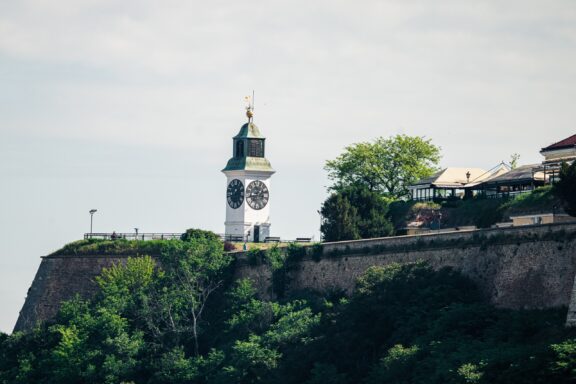
As is the case with Belgrade, a fortress is one of the primary attractions for tourists who visit Novi Sad. This one has earned the nickname “Gibraltar on the Danube” for its position on a rock overlooking the water of the Danube. The clock tower here is a famous sight.
Visitors can take part in a nighttime guided tour of the fortress to enjoy ghost stories and a unique experience.
2. Danube Park
Danube Park is located in the center of Novi Sad, in the city’s Stari Grad neighborhood. It was once a large bog formed by the Danube River, but the city decided to turn it into a park in 1895. Now, the park is home to more than 250 plant species and covers over 33,000 m2 (108,268 m2).
Visitors in Novi Sad looking for a break from the city in a natural setting are likely to find peaceful moments at Danube Park.
3. The Bishop’s Palace
As an important cultural city for Serbia, Novi Sad is even where Porfirije Peric, the current Bishop of the Serbian Orthodox Church resides. The palace is not open to visitors because it functions as a private residence, but anyone can admire the palace from the outside.
The original palace was constructed in the same location in 1741, but it was destroyed in a bombing in the 1800s. The current palace was built at the beginning of the 20th century. There is also a statue of Serbian poet Jovan Jovanovic Zmaj in front of the palace.
Niš
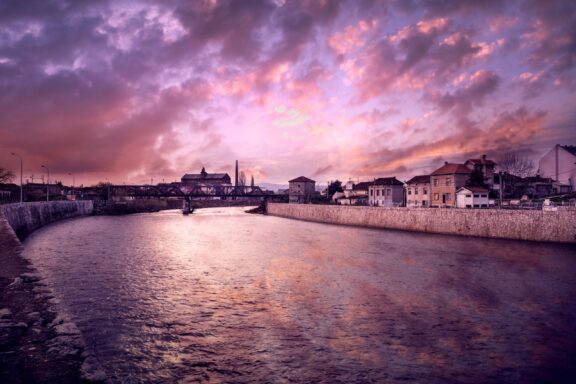
Niš is the third largest city in Serbia and is located in the southern part of the country. It’s famous for having been the birthplace or residence of several Roman emperors. The city now has an international airport and is an important economic center for Serbia, especially in the industries of electronics, mechanical engineering, and textiles.
The population of Niš is about 184,740 in 2022, and the city covers 597 km2 (230 mi2) of land.
Things to see and do in Niš
1. The Skull Tower
The Skull Tower is an interesting site to visit in Niš if you’re not averse to the macabre. As the name suggests, it is a wall made of the skulls of rebels that fought in the Battle of Čegar during the First Serbian Uprising in 1809.
2. Niš Fortress
The famous fortress in Niš is free for anyone to visit and offers unique access to a monument of great historical and cultural significance. The current fortress was constructed by the Ottomans at the beginning of the 18th century, and it’s one of the best-preserved structures in the region from this period.
Map of Serbia with the Largest Cities
Serbia Economy Facts
| World Bank Income Group | Upper middle income |
| World Bank Region | Europe & Central Asia |
| Currency | Serbian Dinar (RSD) |
| GDP in 2020 | $53.3 (billions of USD) World Rank: 84 |
| GDP per capita in 2020 | $7,731 World Rank: 77 |
| Major Industries / Economic Sectors | Manufacturing, services, agriculture, energy |
| Top 5 Import Countries | Germany, Italy, China, Austria, Hungary |
| Top 5 Export Countries | Germany, Italy, China, Hungary, Austria |
Government and Politics in Serbia
The government of Serbia is a parliamentary republic that includes judicial, legislative, and executive branches. The President of the Republic is the head of state and is elected by popular vote to a maximum of two five-year terms. The Prime Minister is appointed by the President.
Serbia’s first constitution from 1835 was one of the first modern constitutions in Europe and was considered to be among the most progressive and liberal at the time. The country has since had ten new constitutions, the last coming after Serbia’s 2006 split with Montenegro.
Tourist Attractions in Serbia
It might not be the most popular tourist destination in Europe, but that doesn’t mean there aren’t plenty of reasons to visit Serbia. Spas, mountains, and the bustling capital of Belgrade are the biggest tourist draws in Serbia. Read on to learn more about some of the best tourist attractions in Serbia.
Uvac River Canyon
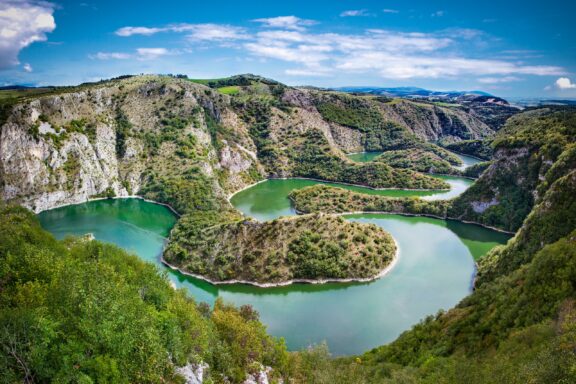
The Uvac River Canyon is one of the most stunning natural locations in Serbia. The deep river canyon winds through a large nature reserve in the southwestern part of the country and is home to endangered plants and animals such as the griffon vulture. There is also an extensive cave system, and guided tours are available.
Church of St. Sava
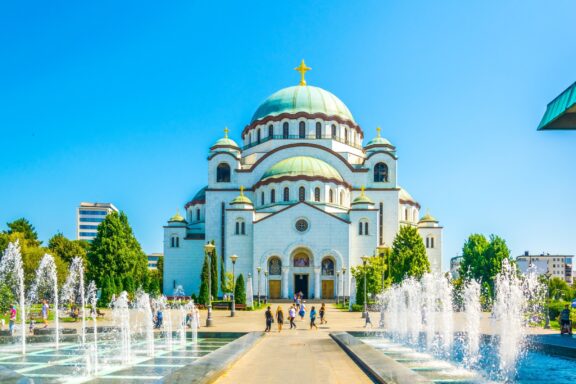
One of the architectural and cultural highlights of Belgrade, this is one of the largest Eastern Orthodox Churches in the world. It was constructed on the location of St. Sava’s grave and completed in 2004 after almost 70 years of construction.
Skull Tower
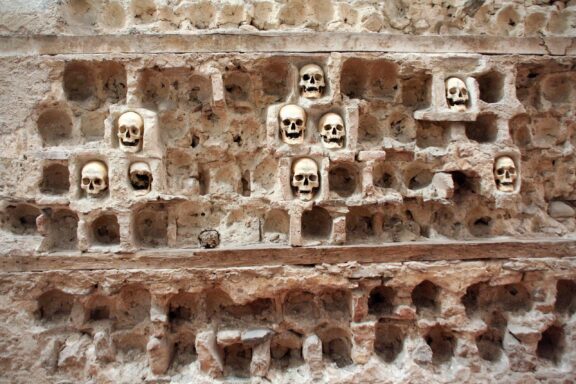
A visit to the Skull Tower in Serbia’s Niš promises to be unique, informative, and just a little creepy. The tower is a monument built in honor of the sacrifices made during centuries of Ottoman rule and consists of about 60 human skulls.
Transportation and Infrastructure of Serbia
Since it’s a landlocked country in Europe, accessing Serbia is possible by just about every mode of transportation except by boat. The country’s largest airport is Belgrade Nikola Tesla Airport, and Air Serbia is the largest Serbian airline.
Bus routes from all over Europe lead to Belgrade, and trains from nearby capitals lead to the capital city.
Once inside Serbia, getting around the country is most easily done by car rental or bus. There is an extensive bus system that connects the country, and taxis are available in larger cities.
Climate and Weather of Serbia
The Serbian climate varies from north to south. Northern Serbia has a continental climate that consists of cold, dry winters, and warm, humid summers. Southern Serbia features more of a Mediterranean climate with cool, rainy winters and hot, dry summers.
The mountains of Serbia experience heavy snowfall, and June is the month with the greatest amount of rainfall.
Serbia Related Content
Serbia Key Facts
| Country | Serbia |
| Coordinates | Latitude: 44.016521 Longitude: 21.005859 |
| Country Codes | Alpha 2: RS Alpha 3: SRB |
| Country Flag Emoji | 🇷🇸 |
| Int. Phone Prefix | +381 |
| Capital city | Belgrade |
| Continent Subcontinent | Europe Southern Europe |
| Country Area | 77,474 sq km |
| Population 2021 | 6,844,078 World Rank: 106 |
| Median Age | 42.9 |
| Life expectancy | 74.2 |
| Major languages | Serbian (official) 88.1%, Hungarian 3.4%, Bosnian 1.9%, Romani 1.4%, other 3.4%, undeclared or unknown 1.8% (2011 est.) |
| UTC/GMT Time | Number of time zones: 1
|
| Internet TLD | .rs |
| Biggest Airport | Belgrade Nikola Tesla Airport (BEG) |
| Average temperature | 10.55 °C 50.99 °F |
| Administrative Divisions | 2 autonomous provinces 1 city 29 districts |
| Political system | Parliamentary democracy |
Serbia FAQs
Is Serbia part of Russia?
No, Serbia is an independent nation in Southeastern Europe, and it doesn’t share a border with Russia. Both countries are predominantly Slavic and Eastern Orthodox, and Serbia was part of Yugoslavia until the 1990s, which was a Soviet Nation but was never part of the Soviet Union. Some people confuse Serbia with Siberia, which is a region in Russia.
Is Serbia a NATO member?
No, Serbia is not a member of NATO. It is pursuing membership in the European Union, but it is part of the Non-Aligned Movement of countries that have not joined large political alliances.
What language do they speak in Serbia?
The official language in Serbia is Serbian. The language belongs to the western group of South Slavic Lanugages and is very similar to Bosnian, Croatian, and Montenegrin.